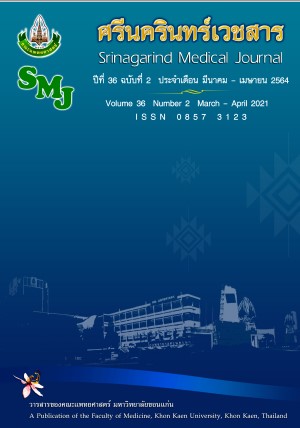ปัจจัยที่ส่งผลต่อความผิดปกติจากเอกซเรย์คอมพิวเตอร์ในกรณีสมองบาดเจ็บไม่รุนแรงที่มีความเสี่ยงสูง
Abstract
หลักการและวัตถุประสงค์: การบาดเจ็บทางสมองเป็นปัญหาที่สำคัญทั่วโลก สาเหตุของการบาดเจ็บทางสมองส่วนใหญ่เกิดจากอุบัติเหตุจราจรและการพลัดตกหกล้ม ในกรณีสมองบาดเจ็บไม่รุนแรงนั้นมีหลายปัจจัยที่ส่งผลต่อความผิดปกติทางสมอง อย่างไรก็ตาม ยังไม่มีการศึกษาถึงปัจจัยที่มีผลต่อความผิดปกติทางสมองจากการตรวจเอกซเรย์คอมพิวเตอร์ของผู้บาดเจ็บทางสมองในประเทศไทยเท่าใดนัก
วิธีการศึกษา: การศึกษาเชิงพรรณนาในผู้บาดเจ็บสมองไม่รุนแรง (ระดับการรับรู้สติกลาสโกว์ 13-15) ที่มีความเสี่ยงสูงที่จะพบความผิดปกติจากการตรวจเอกซเรย์คอมพิวเตอร์ เพื่อหาอัตราส่วนในการพบความผิดปกติและปัจจัยที่ส่งผลต่อการพบความผิดปกติจากการตรวจเอกซเรย์คอมพิวเตอร์สมอง
ผลการศึกษา: จากการศึกษาผู้บาดเจ็บสมองไม่รุนแรงที่มีความเสี่ยงสูง 117 ราย พบว่า ผู้บาดเจ็บ 41 ราย (ร้อยละ 35) มีความผิดปกติจากการตรวจเอกซเรย์คอมพิวเตอร์ และพบปัจจัยที่มีผลต่อการพบความผิดปกติอย่างมีนัยสำคัญทางสถิติ คือ การมีระดับความรับรู้สติกลาสโกว์ 13-14 หลังจากการติดตามการรักษา 5 ราย (p=0.011) และ อาการแสดงของฐานกะโหลกแตกหรือกะโหลกแตกแบบเปิด 5 ราย (p=0.037)
สรุป: ลักษณะอาการแสดงของฐานกะโหลกแตกหรือกะโหลกแตกแบบเปิดและการมีระดับความรับรู้สติกลาสโกว์ 13-14 หลังจากการติดตามการรักษาสามารถใช้เป็นตัวทำนายที่บ่งชี้ถึงการตรวจพบความผิดปกติในสมองจากเอกซเรย์คอมพิวเตอร์ในผู้บาดเจ็บสมองไม่รุนแรง
คำสำคัญ: การบาดเจ็บที่ศรีษะ; การบาดเจ็บที่สมอง; การถูกกระทบกระแทกในสมอง; การตกเลือดในกะโหลกศีรษะ
Background and Objective: Traumatic brain injury is one of the most significant problems worldwide. Major causes of head injury are caused by traffic accidents and fallings. In mild traumatic brain injury, consider that there are risk factors for abnormalities in the brain. However, there is a lack of study in risk factors for neurosurgical intervention related to abnormal CT findings in Thai people.
Method: Retrospective descriptive study in the patients diagnosed mild traumatic injury (GCS 13-15), with high risk for abnormalities in CT scan. The outcome of the study is to admeasure the ratio of abnormal CT findings and to determine factors that affected abnormal CT findings.
Results: There were 117 mild traumatic brain injury – high-risk patients performed a CT scan. Of those, 41 patients (35%) had abnormal CT findings. Two significant factors affecting abnormal CT findings; GCS 13-14 after observation and signs of open/base of skull fractures with a number of 5 (p£0.011) and 5 (p=0.037), respectively.
Conclusion: Open skull or base of skull fracture and GCS of 13-14 observation were the most two strongest predictors for abnormal CT scan in mild traumatic brain injury – high-risk patients.
Key words: head injury; traumatic brain injury; cerebral concussion; intracranial hemorrhage


